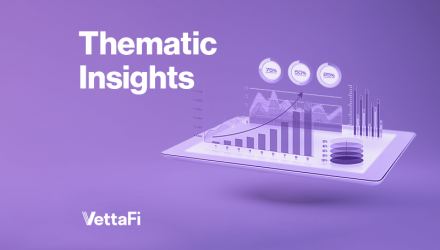Last week, I discussed some of the different types of crypto and bitcoin ETFs. The distinction between futures-based ETFs and crypto equity ETFs is clear when you look closely at the two. But even when examining them closely, it may be difficult to distinguish between the different types of blockchain/crypto equity ETFs because of similarities with fintech, metaverse, and Web3 concepts. This note serves as a continuation of last week’s note and looks more closely at the differences between blockchain ETFs, metaverse ETFs, Web3 ETFs, and more.
Blockchain: The Future of Tech and Finance
If you’re already a crypto fan — you should be familiar with the term blockchain. Blockchain is a type of technology where transaction data is stored on a distributed (peer-to-peer) shared ledger. The Bitcoin blockchain is the most well-known blockchain; however, use cases extend beyond digital assets into supply chain and other financial transactions.
Blockchain ETFs are a type of industry ETF or thematic ETF — these typically have high correlation with Bitcoin prices but also play on themes of the crypto economy, digital transformation, or the future of finance.
Generally, these ETFs hold the typical crypto-related equities including Coinbase (COIN), Microstrategy (MSTR), and the crypto miners. Some of these are more specific — for example, the Valkyrie Bitcoin Miners ETF (WGMI) is the only remaining crypto mining ETF after the closures of RIGZ and DAM earlier in 2023. These ETFs may also focus more specifically on the digital economy and fintech like the Grayscale Future of Finance ETF (GFOF) which contains holdings like Robinhood Markets (HOOD) and PayPal Holdings (PYPL). See last week’s note for more details.
Where is the metaverse?
I covered the metaverse briefly in a note last year. While this is a concept that had been around for many years (video games, avatars, social media), the idea became more popular during the pandemic when people had no choice except to interact with each other online. During this time, Roblox Corp (RBLX) grew in popularity and had its IPO on March 10, 2021.
The first true metaverse ETF, the Roundhill Ball Metaverse ETF (METV), was created in June 2021. This is currently the largest metaverse ETF with $439 million in assets. Then in October 2021, Facebook also changed its name to Meta Platforms and emphasized a push for investment into its metaverse and virtual reality platforms — further supporting the idea of the metaverse. Several other metaverse ETFs launched since then including the Fount Metaverse ETF (MTVR) in October 2021, the Proshares Metaverse ETF (VERS) in March 2022, and the First Trust Indxx Metaverse ETF (ARVR), the Fidelity Metaverse ETF (FMET), and the Global X Metaverse ETF (VR) all in April 2022.
Are Crypto And The Metaverse The Same?
Cryptocurrency is loosely related to the metaverse. However, crypto companies are not typically considered part of the metaverse ecosystem and companies like Coinbase, Silvergate, and the crypto miners are not found in metaverse ETFs. Instead, these ETFs hold mostly information technology and communications services stocks like Nvidia Corp (NVDA), Apple Inc (AAPL), RBLX, Meta Platforms (META), Microsoft Corp (MSFT), Adobe Inc (ADBE), and Alphabet Inc (GOOGL).
Along with the metaverse, NFTs also became popular during the peak of the crypto cycle, although there were very few public companies that dealt with NFTs. On December 2, 2021, the Defiance Digital Revolution ETF (NFTZ) launched. This was the first ETF that targeted exposure to NFTs; however, holdings looked very similar to other blockchain ETFs. At its launch it held only a few differentiated companies like PLBY Group (PLBY) and Funko Inc (FNKO). This ETF closed on March 30, 2023 (around the same time as the RIGZ, BTCR, and DAM closures).
What is Web3?
The early days of the internet were considered “Web 1.0” and focused on “read-only” functionality. Web 2.0 evolved into “read and write” with more interactive and social networking apps like Facebook, Google, and Youtube.
Web3 focuses on “reading, write, and own,” and includes content ownership and user creation. Many people use this term interchangeably with the metaverse, but Web3 is a broader term that encompasses the metaverse, blockchain, NFTs, big data, and artificial intelligence.
There are only a couple of ETFs which use Web3 in their name: the SoFi Web 3 ETF (TWEB) and the Bitwise Web3 ETF (BWEB) which launched in August and October 2022, respectively. These ETFs tend to look like a combination of a metaverse ETF and a blockchain ETF. This includes holdings like Riot Platforms (RIOT), NVDA, META, Draftkings (DKNG), Coinbase (COIN), and Shopify (SHOP).
Although TWEB has only $1.2 million assets and BWEB has only $0.7 million in assets, these ETFs have been outperforming broader communication services and technology sector ETFs due to their mix of mega-cap internet/tech stocks and crypto stocks.

Bottom Line
Investors interested in thematic digital transformation equity ETFs have several different options that are very similar but may appeal to different investors. For those that want to invest in crypto-related companies with a high correlation to the price of Bitcoin, blockchain/crypto economy ETFs are the most appropriate. These can serve as a complement to an existing technology sector or financial sector allocation. Those that want to invest in the future of the internet from the perspective of gaming, social media, and virtual reality may prefer an allocation to metaverse ETFs.
Those investors wanting a broader approach to the future digital economy including blockchain, metaverse, and more may consider a Web3 ETF. It is important to note that while Web3 ETFs have been outperforming peers YTD, these ETFs are newer and have significantly less assets.
For more news, information, and analysis, visit the Crypto Channel.

